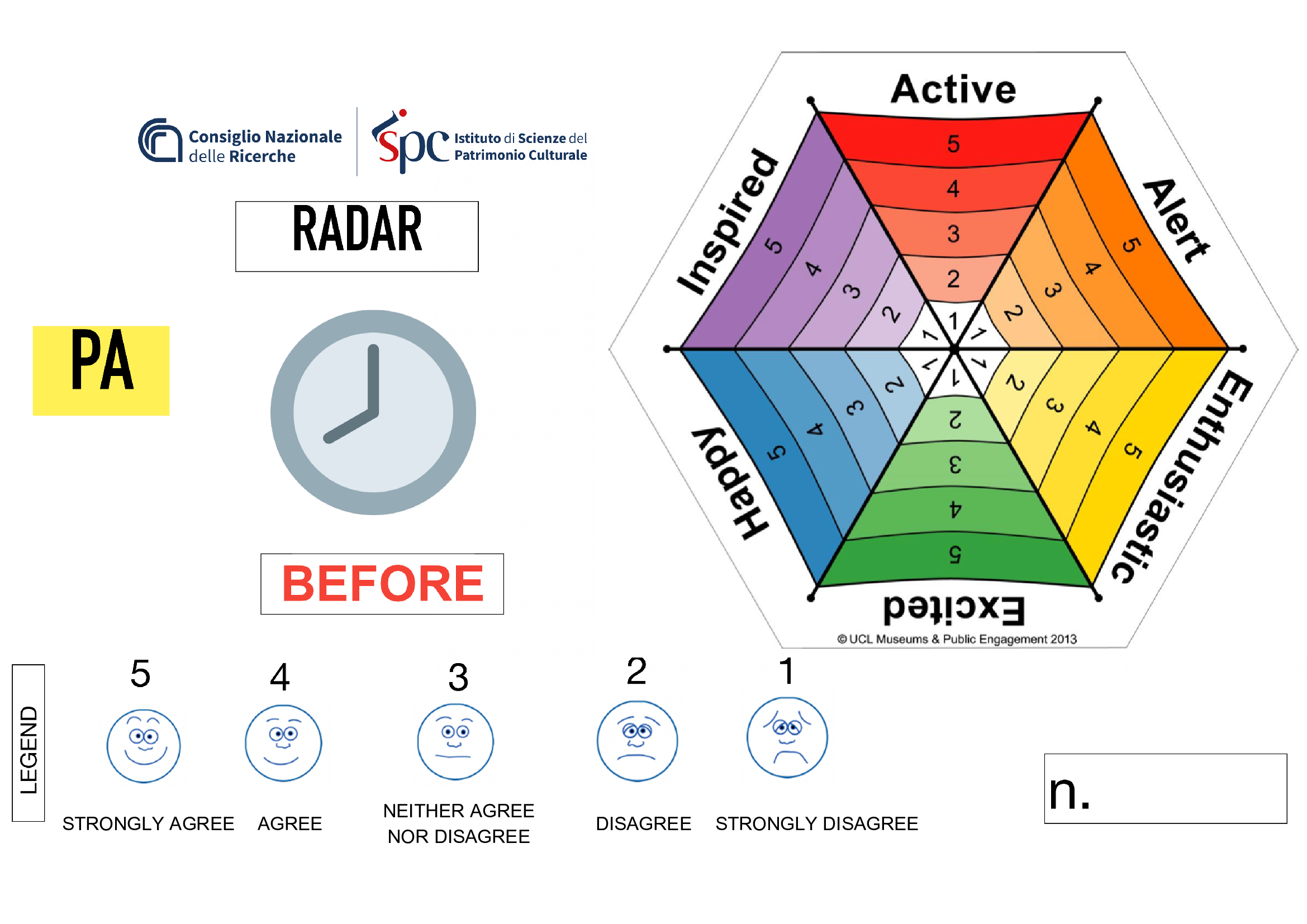Month: November 2024
RADAR TOOLKIT: a Glimpse into our chosen Evaluation Method for the Culture&Health Pilot Actions
PERFARE has chosen to investigate and make use of existing methods for measuring and evaluating culture's societal effect on culture and health by seeing opportunities in systems and methods that were already developed and implemented.
After some research, the RADAR Toolkit was chosen as the best fitting to the project case, easily applicable for the welfare stakeholders who joined PerFare at the very beginning and for the artists selected via call.
In fact, RADAR consist in immediately applicable tools for the measurement of the impact of art&culture on the user, both before and after the experience. It was created as part of the Inclusive Arts and Culture (ICA) project of the Institute of Cultural Heritage Sciences of the National Research Council (ISPC CNR) through a co-design process with users and communities, cultural professionals, caregivers, doctors and geriatricians, occupational therapists, psychiatrists, educators and psychologists.
The RADAR toolkit includes a set of accessible tools to measure the impact of participation in cultural and creative activities on well-being and connection with art and cultural heritage. This tool was developed to be used both in cultural and creative contexts (museums and galleries, archives, libraries, theaters and festivals) and in places of education, assistance and care (day and residential centres, hospitals), to support culture and creativity in a cultural welfare perspective.
Methodology
The measurement tools included in the toolkit were defined starting from experiments with good practices spread internationally, in particular from the umbrellas of evaluating emotional well-being included in the University College of London Museum Wellbeing Measures Toolkit (Thompson &
Chatterjee, 2013; Thompson et al., 2011; 2012a;b) and Inclusion of Nature in Self Scale (Schultz, 2002; Mayer & Frantz, 2004), adapted to evaluate the sense of connection with art and cultural heritage.
There are currently four versions of the Wellbeing Measures Umbrella available to use comprising the:
- ‘Positive Wellbeing Umbrella – Generic’;
- ‘Negative Wellbeing Umbrella – Generic’;
- ‘Positive Wellbeing Umbrella - Older Adult’;
- ‘Positive Wellbeing Umbrella - Younger Adult’.
All Wellbeing Umbrellas consist of a hexagonal shape with six sections of different colours. A variety of colour schemes were trialled for the Wellbeing Measures Umbrellas resulting in warm colours for the Positive Wellbeing Umbrella, cool colours for the Negative Wellbeing Umbrella, richer colours for the Older Adult Umbrella and fluorescent colours for the Younger Adult Umbrella.
Each of the six sections has a word next to it related to a wellbeing mood or emotion and numbers from one to five. Participants are required to rate the extent they feel the wellbeing word at that moment in time by circling the appropriate number, following the instructions provided.
The Wellbeing Measures Umbrella is both highly visual and intuitive to complete in that the greater the number, the more intense the colour and the bigger the area it occupies. The Wellbeing Umbrellas can be used after an activity but ideally two measures should be taken, the first before the activity to act as a baseline measure and the second after the activity so that any changes in participant wellbeing can be compared. The ‘before’ and ‘after’ measures can also be taken over time, for example, at the start of a programme of activities, after several weeks and at the end.
The toolkit RADAR, like the UCL tool, includes Positive Affect categories and Negative Affect Scales – PANAS (Watson et al., 1988; Terracciano et al., 2003) and the Visual Analogue Scale - VAS (EuroQol Group, 1990).
A further useful tool for the development of RADAR with respect to the social well-being parameter is represented by the Center for Epidemiologies tool Studies Depression Scale (CES), with particular reference to the single question of scale 4 relating to 'feeling alone'. To extend the accessibility of
the toolkit, the WBFPRS: Wong Baker Faces Pain Rating Scale (Garra et al., 2010) has also been introduced.
How to use the tool
RADAR was designed to be accessible in design, content and compilation procedure. It is made up of three tools that measure the impact that participation in cultural and creative experiences can have on the emotional well-being and sense of connection between the user and art&culture.
Specifically, the toolkit includes the following tools, illustrated in the figure below:
• two tools to self-evaluate the perceived affective state based on the ranges of positive (Positive Affect - PA) and negative (Negative Affect - NA) moods and emotions, before and after the cultural/creative experience;
• a tool to self-evaluate the sense of connection perceived with art or cultural heritage, before and after the cultural/creative experience.






The tools in the RADAR toolkit are quick to compile and can be filled in directly by the cultural user, or alternatively, a facilitator can guide the person who took part in the experience in filling them out. The compilation allows the user to become aware of the changes that have emerged following the visit or the creative and cultural experience. The data can also be used by cultural operators or by educational and social-health professionals to obtain feedback on the impact of the experience.

